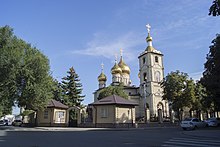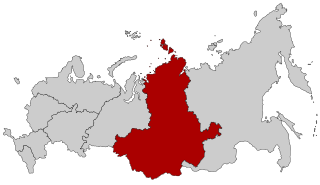
Siberian Federal District is one of the eight federal districts of Russia. Its population was 17,178,298 according to the 2010 Census, living in an area of 4,361,800 square kilometers (1,684,100 sq mi). The entire federal district lies within the continent of Asia.

The Republic of Adygea, also known as the Adyghe Republic, is a republic of Russia. It is situated in the North Caucasus of Eastern Europe. The republic is a part of the Southern Federal District, and covers an area of 7,600 square kilometers (2,900 sq mi), with a population of roughly 496,934 residents. It is an enclave within Krasnodar Krai and is the fifth-smallest Russian federal subject by area. Maykop is the capital and the largest city of Adygea, home to one-third of the republic's population.

Ivanovo Oblast is a federal subject of Russia. It had a population of 927,828 as of the 2021 Russian Census.

Circassians, also called Cherkess or Adyghe, are an indigenous Northwest Caucasian ethnic group and a nation; native to the historical country-region of Circassia in the North Caucasus. As a consequence of the Circassian genocide perpetrated by the Russian Empire in the 19th century during the Russo-Circassian War, most Circassians were exiled from their homeland in Circassia to modern-day Turkey and the rest of the Middle East, where most of them are today. In the early 1990s, the Unrepresented Nations and Peoples Organization estimated that there are as many as 3.7 million Circassians in diaspora in over 50 countries.

The Far Eastern Federal District is the largest of the eight federal districts of Russia but least populated, with a population of around 8 million according to the 2021 Census. The federal district lies entirely within the easternmost part of Asia and is coextensive with the Russian Far East.

Kabardino-Balkaria, officially the Kabardino-Balkarian Republic, is a republic of Russia located in the North Caucasus. As of the 2021 Census, its population was 904,200. Its capital is Nalchik. The area contains the highest mountain in Europe, Mount Elbrus, at 5,642 m (18,510 ft). Mount Elbrus has 22 glaciers that feed three rivers — Baksan, Malka and Kuban. The mountain is covered with snow year-round.

The Kabardians or Kabardinians are one of the twelve major Circassian tribes, representing one of the twelve stars on the green-and-gold Circassian flag. They are also commonly known by the plural terms Kabardin, Kebertei, or Kabarday. Along with the Besleney tribe, they speak a distinctive dialect of the Circassian. Historically the Kabardians lived in Kabardia, a region of the north Caucasus. In modern times the Kabardians live mostly in the Russian republic of Kabardino-Balkaria, which partly corresponds to the historic region.

Religion in Russia is diverse, with Orthodox Christianity being the most widely professed faith, but with significant minorities of non-religious people and adherents of other faiths. A 1997 law on religion recognises the right to freedom of conscience and creed to all the citizenry, the spiritual contribution of Orthodox Christianity to the history of Russia, and respect to "Christianity, Islam, Buddhism, Judaism and other religions and creeds which constitute an inseparable part of the historical heritage of Russia's peoples", including ethnic religions or paganism, either preserved, or revived. According to the law, any religious organisation may be recognised as "traditional", if it was already in existence before 1982, and each newly founded religious group has to provide its credentials and re-register yearly for fifteen years, and, in the meantime until eventual recognition, stay without rights.
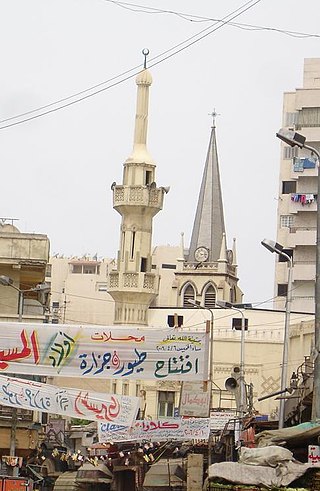
Religion in Egypt controls many aspects of social life and is endorsed by law. The state religion of Egypt is Islam, although estimates vary greatly in the absence of official statistics. Since the 2006 census religion has been excluded, and thus available statistics are estimates made by religious and non-governmental agencies. The country is majority Sunni Muslim, with the next largest religious group being Coptic Orthodox Christians. The exact numbers are subject to controversy, with Christians alleging that they have been systemically under-counted in existing censuses.

Religion has been a major influence on the societies, cultures, traditions, philosophies, artistic expressions and laws within present-day Europe. The largest religion in Europe is Christianity. However, irreligion and practical secularisation are also prominent in some countries. In Southeastern Europe, three countries have Muslim majorities, with Christianity being the second-largest religion in those countries. Ancient European religions included veneration for deities such as Zeus. Modern revival movements of these religions include Heathenism, Rodnovery, Romuva, Druidry, Wicca, and others. Smaller religions include Indian religions, Judaism, and some East Asian religions, which are found in their largest groups in Britain, France, and Kalmykia.

Christianity is the largest religion in Luxembourg, with significant minorities of non-religious people and adherents of other faiths.
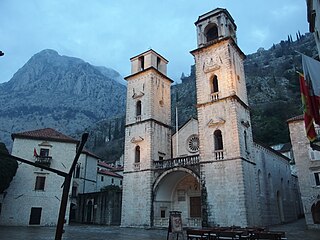
Eastern Orthodox Christianity is largest religion in Montenegro, but there are also sizeable numbers of adherents of both Catholic Christianity and Islam.

Religion in Bulgaria has been dominated by Christianity since its adoption as the state religion in 864. The dominant form of the religion is Eastern Orthodox Christianity within the fold of the Bulgarian Orthodox Church. During the Ottoman rule of the Balkans, Islam spread to the territories of Bulgaria, and it remains a significant minority today. The Catholic Church has roots in the country since the Middle Ages, and Protestantism arrived in the 19th century; both of them remain very small minorities. Today, a significant part of the Bulgarians are not religious, or believers who do not identify with any specific religion, and Bulgaria has been the cradle of some new religions, notably the Neo-Theosophical movement of Dunovism.
The Turkmen of Turkmenistan, are predominantly Muslims. According the U.S. Department of State's International Religious Freedom Report for 2022,
According to U.S. government estimates, the country is 89 percent Muslim, 9 percent Eastern Orthodox, and 2 percent other. There are small communities of Jehovah's Witnesses, Shia Muslims, Baha’is, Roman Catholics, the International Society for Krishna Consciousness, and evangelical Christians, including Baptists and Pentecostals. Most ethnic Russians and Armenians identify as Orthodox Christian and generally are members of the Russian Orthodox Church or Armenian Apostolic Church. Some ethnic Russians and Armenians are also members of smaller Protestant groups. There are small pockets of Shia Muslims, consisting largely of ethnic Iranians, Azeris, and Kurds, some located in Ashgabat, with others along the border with Iran and in the western city of Turkmenbashy.

The main religion traditionally practiced in Latvia is Christianity. As of 2019, it is the largest religion (68.84%), though only about 7% of the population attends religious services regularly.
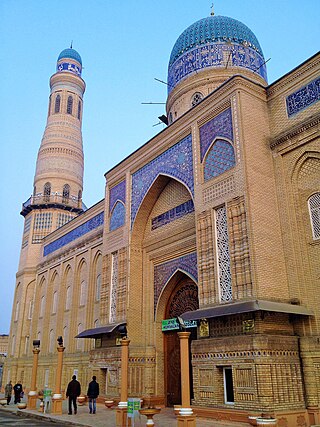
Islam is the predominant religion in Uzbekistan.
Irreligion was the official state policy during the Soviet Union and was rigorously enforced. This led to the persecution of Christians in the country. Since the collapse of Communism, Russia has seen an upsurge of religion. Adding together those who are undecided, those who are spiritual but not religious, and those who are atheistic, as of a 2012 survey, 27.5% of Russians claim no particular religious affiliation.

The Adyghe Khabze or Circassian Khabze, also known as Khabzism, is the worldview and moral code of the Circassian people. Circassian society dictates that a Circassian must always live according to rules defined by the Khabze with little exceptions. Tenets of Khabze include special respect for elders and women, a policy of only marrying those from Circassian culture to protect the endangered culture, and the values of truthfulness, honor and bravery. While rooted in thousands of years of tradition, Khabze is evolving and ever-changing, and is reformed to fit the needs of the Circassian community. This is usually led by a themade.
Caucasian Neopaganism is a category including movements of modern revival of the autochthonous religions of the indigenous peoples of the North Caucasus. It has been observed by scholar Victor Schnirelmann especially among the Abkhaz and the Circassians.

Circassian paganism, also called Khabzeism or Khabzism, is the ethnic religion of the Circassians. It is based on worshipping the supreme god Theshkhue (Тхьэшхуэ) and other minor deities under his rule, to each of whom is attributed an element, action or item of veneration and control. The religion also strongly focuses on the perfection of the soul, developing spiritual maturity and honour until a practitioner may enter the heavens, in union with their ancestors.

